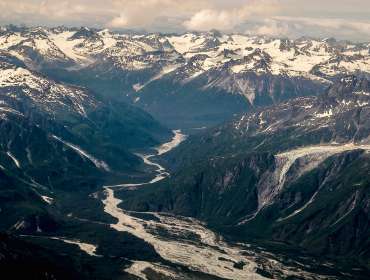In its native Maori tongue, New Zealand is called “Aotearoa,” meaning “Land of the Long White Cloud.” It’s not hard to see why. Look at satellite pictures of New Zealand and you’ll see two long skinny islands with a smaller dot of land below, defined by a backbone of mountains running almost the full length of the country. If you can see the mountains beneath the long line of white cloud that is.


The Southern Alps that form the spine of New Zealand sit abreast the joining of the Australian and Pacific tectonic plates. The ridge line formed by this primordial union – separating the vast Tasman Sea and Pacific Ocean weather patterns either side – throw up the high levels of precipitation that give this country it’s Maori name. Add in New Zealand’s elongated shape and isolated position in the South Pacific and you have a country with dramatically different geographical and climate regions; home to a wonderfully unique range of native flora and fauna.
New Zealand is distinct from almost every other continent in that its wildlife is not dominated by land mammals – it has only two native species of bat. But its large areas of uninhabited evergreen forest and sheer miles and miles of rugged coastline provide a natural environment for around 80,000 native species of plants, birds, reptiles, insects and marine life – the greater proportion of which are endemic to this country. From giant snails to the world’s smallest dolphin, trees that live for 2,000 years and a buttercup that grows 3 feet tall, birds that don’t fly and around 7,500 different species of fungi, this is a land of unique and unexpected diversity.


Which is what makes exploring and photographing New Zealand such a special experience. On no other continent can you see such a wide variety of landscapes, flora, fauna and weather patterns all in such close proximity. However, for me, it is the Southern Alps of the South Island that create the real magic. Growing up amongst these incredible peaks they will always seem like home, and photographing the South Island of New Zealand is one of my personal photography highlights.
Being the larger of New Zealand’s two main islands, the South Island is less densely populated – meaning a lot of the landscape is untracked and very remote. From Kahurangi National Park in the north through to Fiordland in the South, much of the South Island is made up of National Park areas including the Te Wahipounamu UNESCO World Heritage Site on the West Coast.



Here you will find arguably New Zealand’s most breathtaking scenery – dominated by the snow-capped Southern Alps and trumped by Milford Sound – described by Rudyard Kipling as the “eighth wonder of the world”.
If you explore the largely untouched ranges of these National Parks you can uncover a variety of interesting and distinctive native life, from alpine herb fields through to podocarp forests, large cave spiders, giant weta (a flightless insect similar to a grasshopper), ancient Tuatara lizards, flightless birds and native worms that can grow up to three feet long!
One of New Zealand’s more colorful native birds – in character if not plumage – is the cheeky Kea. Found only in the South Island of New Zealand predominantly in the coastal forests of the West Coast and most alpine regions, these mischievous mountain parrots have developed a strange fondness for the rubber trim found on cars! Many travelers have returned to their vehicle to find the windscreen wipers, door trim, mirror surrounds and much more completely torn apart by their strong, curved beaks. Though it does make them an easy photography subject, Kea’s don’t seem to be particularly wary of humans and you can get quite close to them in the wild. Just watch they don’t take a liking to your camera gear!



A more well known native bird – and one of our national symbols – is the flightless Kiwi. Although scientifically classified as a bird this incredible animal has many mammal-like characteristics. It cannot fly (it has only very small wings), it has no tail feathers (though it does have whiskers like a cat) and its feathers are more like soft fur, it has nostrils at the end of its beak (the only bird species in the world to do so) and it has marrow in its bones and two functioning ovaries (female) just like a human!
A personal favorite to photograph is the Australasian Gannet, with New Zealand home to the vast majority of these birds. Their largest island colonies are on Three Kings, White Island and Gannet Island (over 20,000 birds each), but you can also find them on the mainland at Cape Kidnappers, Farewell Spit, and Muriwai. Because of their ability to ridge soar they are a great bird to photograph in flight, while the patterns they make when you see large numbers of them nesting in their clifftop colonies offer fantastic creative opportunities.
In addition to our many winged natives, New Zealand’s waters welcome numerous species of sealife, and has built a tourism industry around the opportunity to view and swim with both dolphins and seals and to view migrating whales as they cruise our coastlines. From common dolphins such as this mum and baby in Picton near the top of the south island through to enormous sea lions like this one sunning itself on the beach near Dunedin at the bottom of the south island, the animals that call our waters home are prolific and varied.



A more secretive species is the land based Tuatara, a medium sized reptile found only in New Zealand and with direct lineage back 2000 million years, pre-dating even the age of the dinosaurs. Cold blooded and slow moving, if you can find one they are a great photographic subject. However surviving in the wild only on offshore islands around the country, you are more likely to see one in a wildlife refuge or breeding habitat. This juvenile 18-year-old female was photographed in the Auckland Zoological Park. She will continue to grow in size to around age 35. With an average life expectancy of around 60 years, Tuatara can survive substantially longer with many well over 100 years old.
However it is the landscape these species inhabit that most captivates me, and one I enjoy sharing with Photo Tour guests each year as we explore hidden spots and photographic highlights throughout the South Island.


Home to no less than ten National Parks in an area a little smaller than Illinois, the South Island of New Zealand concentrates its population in and around the main cities of Christchurch (population 375,000), Dunedin, (population 127,000), Invercargill (population 54,000) and Nelson (population 50,000). Smaller towns maintain a distinct regional flavor, often developed around local industry, tourism or horticulture. People are friendly and touring through the countryside is a visual pleasure.
My favorite district is the Queenstown Lakes area, where I have a holiday home in the tiny settlement of Glenorchy (gateway to the incredible landscapes of Mt Aspiring National Park, where much of the Lord of the Rings was filmed). From here I can explore the rest of the island, returning often to my favorite spots. With New Zealand’s constantly changing weather patterns, the same scene can present in a hundred different ways and capturing the mood of an area is an ever challenging and rewarding experience.
From mystical land forms and hidden waterways through to the cascading falls along the cliffs of Fiordland… The mountains themselves, and the vastly detailed coastline… There is so much to see and capture in this amazingly photogenic country, considered a “bio diverse hot spot” by scientists, “Middle Earth” by film buffs, and a “must visit” by world travelers. But for me, it is simply home.





